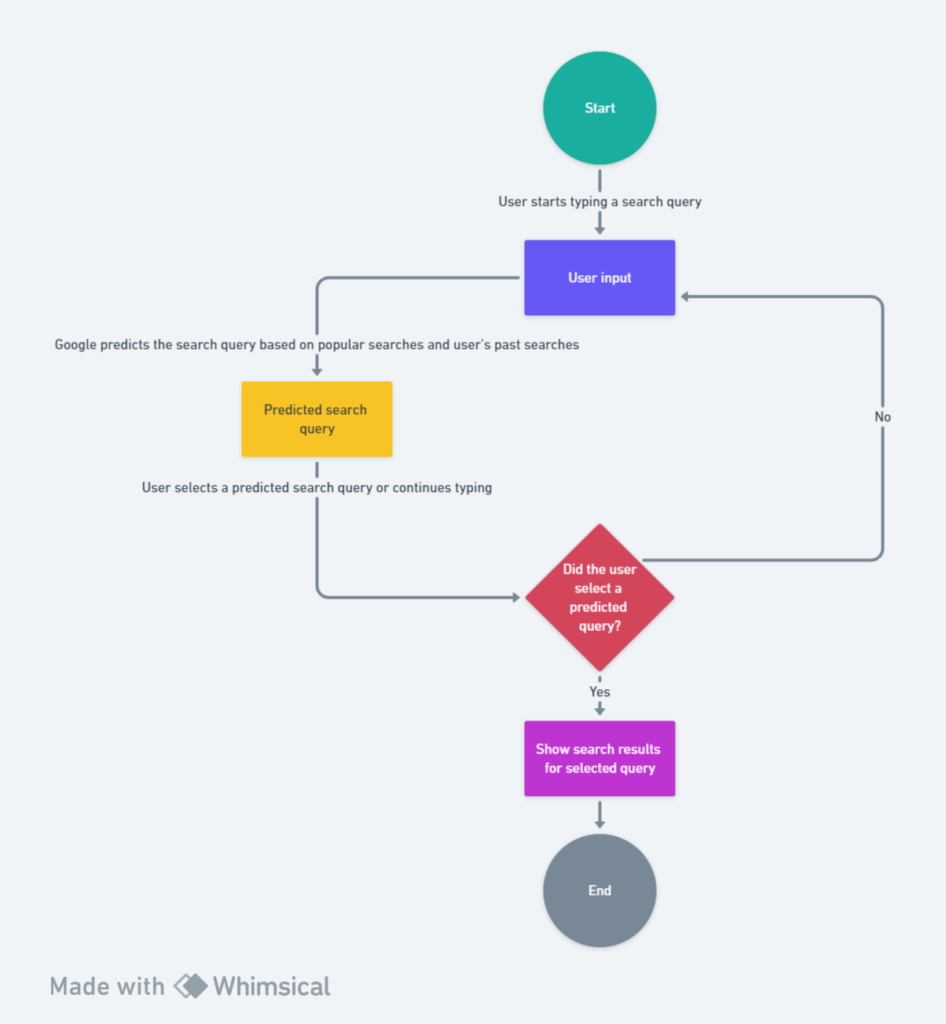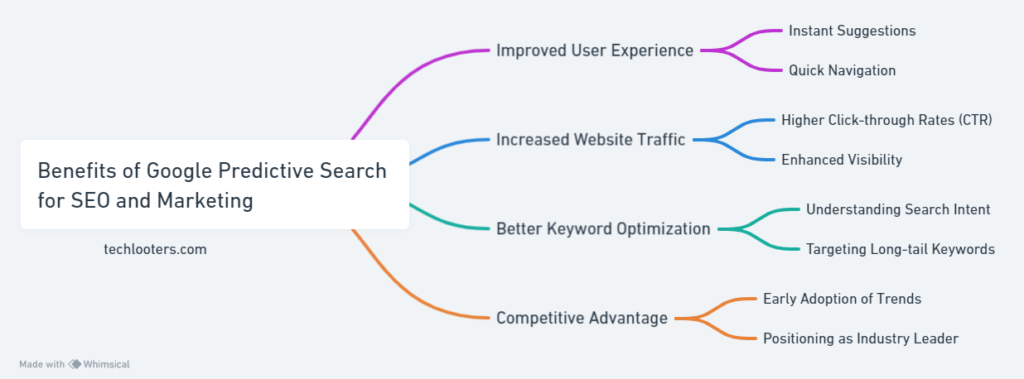Understanding Autocomplete Predictions
Google’s autocomplete predictions or predictive search are those helpful suggestions that appear as you start typing in the search bar. They aim to save time, enhance user experience, and guide users toward relevant search queries. Here’s how they work:
- User Input Analysis: As you type, Google’s algorithm analyzes your partial query. It considers factors like spelling, language, and context.
- Historical Data: Google draws from a vast database of historical search queries. It looks at what other users have searched for in similar situations.
- Popularity and Relevance: The algorithm prioritizes popular and relevant queries. If many users have searched for a specific phrase, it’s likely to appear in the autocomplete suggestions.
- Personalization: Google customizes predictions based on your search history, location, and device. For example, if you often search for local restaurants, autocomplete will offer relevant restaurant-related queries.
Remember, these predictions are dynamic and adapt in real time. So next time you see those dropdown suggestions, know that Google’s predictive algorithm is hard at work!

The Origins of Autocomplete Suggestions
The concept of autocomplete isn’t new—it has roots in early search engines and user interfaces. Google introduced autocomplete in 2004, revolutionizing the way we search. By predicting what users want to find, it streamlines the search process and reduces typing effort.
The underlying technology combines natural language processing, machine learning, and user behavior analysis. As users interact with the system, it continuously refines its predictions, ensuring accuracy and relevance.
Language and Location Relevance
Google’s predictive algorithm is multilingual and location-aware. It adapts to the language you’re typing in and tailors suggestions accordingly. For instance:
- If you’re typing in English, it predicts English queries.
- If you’re in Tokyo, it prioritizes Japanese suggestions.
This localization ensures that autocomplete remains contextually relevant, whether you’re searching for ramen recipes or the latest tech news.
Predicting Long Queries
Autocomplete doesn’t just handle short phrases; it’s adept at predicting longer queries too. Suppose you start typing “best hiking trails near…”—Google’s algorithm instantly suggests relevant locations based on your context and location. It’s like having an AI travel guide at your fingertips!
Freshness and Trending Predictions
Google’s predictive algorithm stays up-to-date with the latest trends. If a breaking news event occurs or a new meme goes viral, autocomplete quickly adapts. Freshness matters, and the system dynamically adjusts its suggestions based on real-time data.
So whether you’re searching for the latest Marvel movie or the best vegan recipes, expect autocomplete to keep pace with the ever-evolving digital landscape.
Customizing Predictions for Topics
Google’s predictive algorithm caters to diverse interests. If you’re passionate about astronomy, it’ll suggest celestial terms. If you’re a coding enthusiast, it’ll offer programming-related queries. The system learns from your behavior and tailors predictions to your areas of interest.
Remember, this customization isn’t just about search—it extends to YouTube, Maps, and other Google services. It’s like having a personalized digital concierge!
Balancing Helpfulness and Diversity
While Google aims to be helpful, it also ensures diversity in its suggestions. It avoids favoring a single viewpoint or promoting harmful content. The algorithm strikes a delicate balance between providing relevant options and avoiding bias.
So the next time you rely on autocomplete to find a nearby coffee shop or troubleshoot a tech issue, appreciate the intricate dance of algorithms behind those dropdown suggestions.
The Role of AI in Google Predictive Search
Google’s predictive search, powered by artificial intelligence (AI), has transformed the way we find information online. Here’s how AI influences this dynamic process:
- Sophisticated Algorithms:
- The foundation of search engines like Google relies on intricate algorithms. These algorithms crawl, index, and rank webpages based on relevance and authority.
- AI-powered algorithms enhance these processes, making search results more accurate, personalized, and efficient.
- Google’s RankBrain:
- One notable example of AI integration is RankBrain. It uses machine learning to understand user intent better.
- When you search for a complex query, RankBrain analyzes patterns, context, and historical data to deliver relevant results.
- Over time, RankBrain adapts to changing search trends, ensuring more precise understanding of user queries.
- Keyword Research and Content Optimization:
- AI automates keyword research and content optimization.
- It identifies semantic relationships between keywords, predicts search trends, and anticipates user behavior.
- For instance, AI tools help content creators optimize their articles by suggesting relevant keywords and improving readability.
- Enhanced User Experience:
- User experience is crucial for SEO. Google prioritizes websites that offer seamless navigation and relevant content.
- AI analyzes user behavior data, identifies areas for improvement, and suggests personalized content.
- For example, personalized recommendations keep users engaged and encourage longer website visits.
- Predictive SEO:
- Predictive SEO leverages AI to forecast future trends and algorithm updates.
- By analyzing historical data, user behavior, and emerging patterns, AI helps businesses stay ahead.
- For instance, AI predicts shifts in user preferences, allowing marketers to adapt their strategies proactively.

Examples of AI Adaptation Over Time
- Search Intent Evolution:
- AI observes how search queries evolve. For instance, during the pandemic, searches shifted from “travel destinations” to “virtual travel experiences.”
- Google adapts by providing relevant content, such as virtual museum tours and online cooking classes.
- Localized Predictions:
- AI considers location-specific trends. If a new restaurant opens in your area, Google predicts local search interest.
- Over time, it refines its understanding of regional preferences.
- Real-Time Updates:
- AI responds swiftly to breaking news or trending topics. For instance, during a major sports event, search results prioritize live scores and updates.
- This adaptability ensures timely and accurate information.
- User Behavior Insights:
- AI analyzes how users interact with search results. If users frequently click on specific types of content (e.g., videos or infographics), Google adapts its rankings.
- Over time, this improves the relevance of search results.
- Semantic Understanding:
- AI comprehends context beyond keywords. It understands synonyms, related terms, and user intent.
- For example, if you search for “best smartphone camera,” AI considers related terms like “photography features” and “low-light performance.”
In summary, AI continually evolves to enhance search experiences. As users, we benefit from more accurate answers, personalized recommendations, and a seamless journey through the digital landscape.
Benefits of Google Predictive Search for SEO and Marketing
1. Highly Targeted Search Terms with Intent
- Long-Tail Keywords: Google’s predictive search suggests highly specific phrases that align with searcher intent. These long-tail keywords often have low search volume but high conversion rates.
- Conversion Boost: By targeting these intent-driven keywords, marketers can attract a more relevant audience, resulting in better conversion rates.
2. Low Competition, Easier Rankings
- Less Competitive: Long-tail keywords typically face less competition compared to broad keywords.
- Ranking Advantage: Marketers can optimize content around these less competitive terms, making it easier to rank higher in search results.
3. Content Ideas and Exploration
- Keyword Research: Predictive search provides a goldmine of content ideas. Explore the autocomplete suggestions to uncover relevant topics and questions.
- Intent Exploration: Understand what users are looking for. For example, a specific long-tail query like “best running shoes for flat feet” reveals clear intent—users want recommendations.
4. User-Centric Approach
- Solving Customer Needs: Long-tail keywords communicate specific customer needs. When you address these needs, your content becomes more valuable.
- Intent-Driven Content: Create content that directly answers user queries. For instance, a user searching for “how to fix a leaky faucet” expects practical solutions.
5. Enhanced User Experience
- Time-Saving: Predictive search saves users time by offering relevant suggestions as they type.
- Mobile Optimization: On mobile devices, where typing is less convenient, predictive search becomes even more valuable.
6. Google Analytics and Insights
- Keyword Insights: Analyze the long-tail keywords you rank for in Google Search Console. Understand user intent behind these queries.
- Behavior Patterns: Observe how users interact with your content. Which long-tail queries lead to conversions? Use this data to refine your strategy.
Leveraging Long-Tail Keywords and User Intent
1. Long-Tail Keywords
- Specificity: Long-tail keywords reflect precise user needs. Optimize content around these specific phrases.
- Conversion Focus: Prioritize keywords that indicate intent to purchase, learn, or solve a problem.
2. Understanding User Intent
- Searcher Goals: Consider why users type specific queries. Are they seeking information, looking to buy, or exploring options?
- Content Alignment: Create content that aligns with user intent. If someone searches for “best budget smartphones,” provide a well-researched list.
3. Content Strategy
- Answering Questions: Long-tail keywords often form questions. Craft content that directly answers these queries.
- Variety: Diversify your content to cover various intent types—informational, transactional, and navigational.
4. SEO Tools and Insights
- Google Autocomplete: Use it as a research tool. Explore autocomplete suggestions for content inspiration.
- Google Search Console: Analyze the long-tail queries driving traffic to your site. Optimize accordingly.
Remember, predictive search isn’t just about keywords; it’s about understanding user needs and delivering valuable solutions. By embracing long-tail keywords and intent-driven content, marketers can enhance their online visibility and connect with their audience effectively.

Managing Online Reputation with Predictive Search
1. Importance of Monitoring Predictive Search Results
- Real-Time Awareness: Predictive search provides real-time insights into how your brand is perceived. It’s like having your finger on the pulse of public opinion.
- Feedback and Sentiment Analysis: Monitoring predictive search helps identify customer sentiment—whether it’s positive or negative.
- Holistic View: Beyond direct mentions and reviews, predictive search covers various channels, including social media, forums, and third-party review sites.
2. Strategies for Effective Online Reputation Management
a. Optimize Social Media Profiles
- Consistent Branding: Ensure your social media profiles reflect your brand identity consistently. Use the same logo, colors, and messaging.
- Engage Actively: Regularly post relevant content, respond to comments, and address customer inquiries promptly.
- Leverage Visuals: Use high-quality images and videos to showcase your brand’s personality.
b. Engage with Your Audience
- Respond to Reviews: Whether positive or negative, engage with reviews. Thank customers for positive feedback and address concerns in a professional manner.
- Be Transparent: If there’s an issue, acknowledge it openly and provide solutions. Transparency builds trust.
- Monitor Mentions: Use tools to track mentions of your brand across platforms. Respond to both direct and indirect mentions.
c. Leverage User-Generated Content (UGC)
- Encourage UGC: Encourage customers to share their experiences through photos, videos, and testimonials.
- Showcase UGC: Feature UGC on your website, social media, and marketing materials. It adds authenticity to your brand.
d. Monitor Your Online Reputation Score
- Similar to a Credit Score: Just as a credit score reflects financial reliability, an online reputation score measures your brand’s reliability.
- Real-Life Example: Banner Health monitored their online reputation score during the pandemic. By analyzing data weekly, they made real-time adjustments to their healthcare services1.
3. Positive Online Reputation Management Examples
- Banner Health: By scrutinizing real-time data, Banner Health improved their course of care during the pandemic, enhancing their online reputation.
- Social Media Engagement: Brands like Wendy’s and Netflix engage humorously with their audience on social media, creating positive associations.
- Prompt Responses: Companies like Zappos and Amazon respond swiftly to customer inquiries, demonstrating excellent customer service.
Remember, managing your online reputation is an ongoing process. Stay proactive, listen to your audience, and adapt your strategies based on predictive search insights..
For more inspiration, explore examples from the Transform conference where brands turned customer interactions into competitive advantages1.
The Power of Google Predictive Search
In our digital age, Google’s predictive search has become an indispensable tool. Let’s recap the benefits and challenges it brings, along with its future implications:
Benefits of Google Predictive Search
- Efficiency: Predictive search saves time by offering relevant suggestions as users type.
- Targeted Keywords: Long-tail keywords, suggested by autocomplete, help marketers reach specific audiences.
- User Intent Insights: Predictive search reveals user intent, allowing content creators to tailor their messaging.
- Real-Time Adaptation: Google adapts to trends, ensuring up-to-date results.
Challenges
- Bias and Controversy: Predictive search can sometimes reinforce existing biases or controversial viewpoints.
- Privacy Concerns: Collecting user data for personalized predictions raises privacy questions.
- Algorithmic Errors: Predictive algorithms occasionally provide inaccurate or irrelevant suggestions.
The Future Implications
- AI Advancements: As AI evolves, predictive algorithms will become even smarter. Expect better understanding of context, intent, and user behavior.
- Hyper-Personalization: Predictive search will offer hyper-personalized results, tailoring content to individual preferences.
- Voice Search Revolution: Voice-based predictive search (think Alexa and Siri) will shape how we interact with technology.
- Beyond Text: Predictive algorithms will extend beyond text search to visual and voice-based queries.
In this dynamic landscape, marketers must stay agile. Understanding predictive search and harnessing its power will be essential for successful search marketing. As AI continues to advance, our search experiences will become more intuitive, efficient, and personalized.
Remember, the journey doesn’t end here. Embrace the ongoing evolution of predictive algorithms, adapt your strategies, and stay ahead in the ever-changing digital realm!





I spent over three hours reading the internet today, and I haven’t come across any more compelling articles than yours. I think it’s more than worth it. I believe that the internet would be much more helpful than it is now if all bloggers and website proprietors produced stuff as excellent as you did.